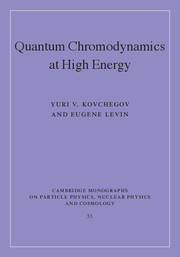Book contents
- Frontmatter
- Contents
- Preface
- 1 Introduction: basics of QCD perturbation theory
- 2 Deep inelastic scattering
- 3 Energy evolution and leading logarithm-1/x approximation in QCD
- 4 Dipole approach to high parton density QCD
- 5 Classical gluon fields and the color glass condensate
- 6 Corrections to nonlinear evolution equations
- 7 Diffraction at high energy
- 8 Particle production in high energy QCD
- 9 Instead of conclusions
- Appendix A Reference formulas
- Appendix B Dispersion relations, analyticity, and unitarity of the scattering amplitude
- References
- Index
7 - Diffraction at high energy
- Frontmatter
- Contents
- Preface
- 1 Introduction: basics of QCD perturbation theory
- 2 Deep inelastic scattering
- 3 Energy evolution and leading logarithm-1/x approximation in QCD
- 4 Dipole approach to high parton density QCD
- 5 Classical gluon fields and the color glass condensate
- 6 Corrections to nonlinear evolution equations
- 7 Diffraction at high energy
- 8 Particle production in high energy QCD
- 9 Instead of conclusions
- Appendix A Reference formulas
- Appendix B Dispersion relations, analyticity, and unitarity of the scattering amplitude
- References
- Index
Summary
The observables discussed in this book so far have been limited to total cross sections and the related structure functions. To calculate these quantities one does not need to impose any constraints on the final state. We now present a small-x calculation of a more exclusive quantity, the cross section for diffractive dissociation, where one requires that the final state has at least one rapidity gap, i.e., a region of rapidity where no particles are produced. We again tackle the problem using the two-step formalism of Chapters 4 and 5: we first calculate the cross sections for quasi-elastic processes using the classical MV/GGM approximation and then include small-x evolution corrections in the resulting expression. For diffractive dissociation where the produced hadrons have large invariant mass, we develop a nonlinear evolution equation that describes the process.
General concepts
Diffraction in optics
Diffraction is a typical process in which we can see the wave nature of particles. When thinking of diffraction one usually pictures the diffraction of light, when a plane wave is incident on an aperture or an obstacle (see Fig. 7.1) and forms a diffraction pattern on the screen behind. The diffraction pattern consists of a bright spot in the middle and a series of maxima and minima of light intensity around it, as shown schematically in Fig. 7.1. The positions of these maxima and minima depend on the size R of the obstacle or aperture (the target), the distance d between the target and the screen (the detector), and the light wavelength λ.
- Type
- Chapter
- Information
- Quantum Chromodynamics at High Energy , pp. 250 - 271Publisher: Cambridge University PressPrint publication year: 2012



